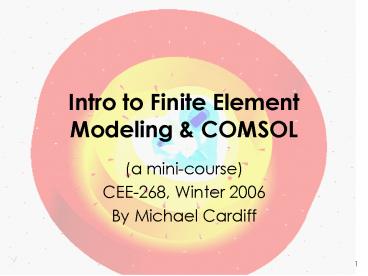Intro to Finite Element Modeling PowerPoint PPT Presentation
1 / 18
Title: Intro to Finite Element Modeling
1
Intro to Finite Element Modeling COMSOL
- (a mini-course)
- CEE-268, Winter 2006
- By Michael Cardiff
2
What is a model?
- Straight from the OED
- a system or thing used as an example to follow
or imitate - a simplified description, especially
a mathematical one, of a system or process, to
assist calculations and predictions.
3
What is a numerical model?
- A model which estimates the solution to a hard
problem (usually a set of PDEs) through numerical
approximations.
4
A finite-difference example
?
- Analytical Solution
- Integrate the expression using calculus tricks
- Plug in BCs to get values for integration
constants
5
A finite-difference example
- Numerical Solution
- Approximate derivatives using numerical tricks
- Write all equations into a single matrix and
solve.
6
A finite-difference example
7
When should we use numerical methods?
- Necessary Assumptions for the methods we have
studied so far - 2-D problems, in plan view generally
- Horizontal-only flow (Dupuit-Forchheimer
assumption) - Isotropic, homogeneous domain
- Steady-state conditions (no change in time)
- Darcys law applies in the full domain
8
When should we use numerical methods?
- To get approximate solutions to problems that
cannot be solved analytically, for example - Problems with complicated geometries and/or
boundaries - Problems with difficult to solve PDEs
- To test the applicability of a simple rule under
a variety of conditions (for example, the
Ghyben-Herzberg relation) - To verify the correctness of an analytical
solution
9
Issues to Remember
- It may take a long time to get your solution (or
you may get a lack of convergence!) - When/if you get a solution, it is only an
approximate solution. - The solutions may be highly dependent on the data
you give to COMSOL (anisotropy, heterogeneity,
etc) - Your data has errors.
10
COMSOL
- Based on the Finite Element (FE) Method
- () FE can handle complex geometries and boundary
conditions with ease. FD is basically restricted
to rectangular shapes. - () FD only tries to minimize error at discrete
points, whereas FE tries to minimize the error
over the entire element (line segments in 1-D,
triangles in 2-D) - () The mathematics behind FE are more involved
than FD.
11
COMSOL
Geometry (CAD)
PDE Definition
COMSOL
Discretization
PDE Solution
Post-Processing
12
COMSOL ?Geometry
- Two options
- Simple UI for 1-D, 2-D, and 3-D
- Points, lines, planes, circles, etc.
- Object mathematics, scaling, rotation, reflection
- Extrusion / Revolving in 3-D
- Import from standard CAD software
- VRML, dxf
13
COMSOL ?PDE Definition
- Pre-defined physical PDEs (coupled through
multi-physics) - OR
- General PDE solution mode
14
COMSOL ?PDE Definition
- Define parameter values within each shape
(subdomain) - Hydraulic conductivity in aquifer
- Define boundary conditions
- Head at specified boundary
- Define known values at points
- Known extraction rate at point-source well
- Couple physics as necessary
- Solute transport (advection/diffusion equation)
coupled to fluid velocity (Darcys Law or N-S
equations)
15
COMSOL ?Discretization
- Automatic Meshing Options
- Element shape (triangular, square)
- Element type (Linear, Quadratic, Cubic)
- Mesh parameters (rate of element growth, mesh
size sensitivity) - Advanced moving meshes / automatic refinement
16
COMSOL ? PDE Solving
- Options
- Transient (time dependent) or Stationary (steady
state) solving - Great assortment of FE algorithms
- UMFPACK, GMRES, Multi-grid, Conjugate Gradient
- Can solve individual parts of problems, store
solutions, or iterate
17
COMSOL ? Post-Processing
- For any given physics, many variables will be
output - Example Darcys law will have head, velocity,
pressure as output - Variety of standard visualizations
- Surface, contour, streamline, arrow, and animated
plots - Further analysis
- Subdomain / boundary integration
- Cross-sectional plots
18
COMSOL
- Compared with other methods of modeling
- () Relatively easy to use graphical interface
- () Uses state-of-the-art solvers and optimizers.
Runs well on a suitably-equipped (lots of RAM)
desktop PC. - () Lots of default options / hidden parameters
- () Interface changes based on what type of
physics you are solving for. Multiphysics gets
even more cumbersome.

